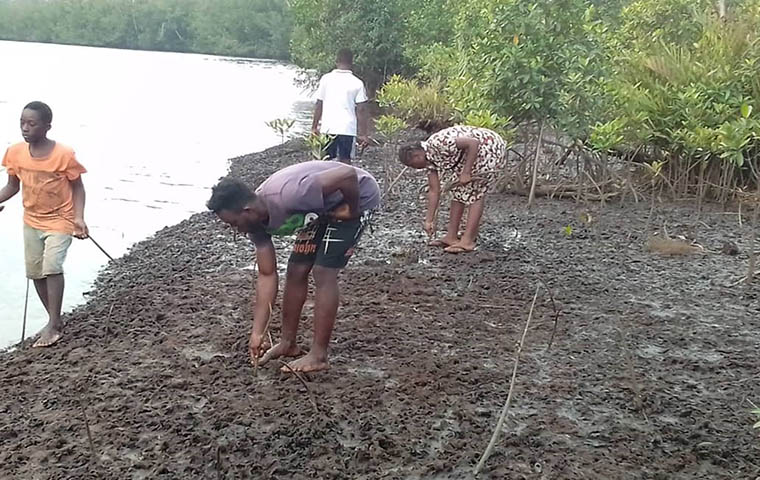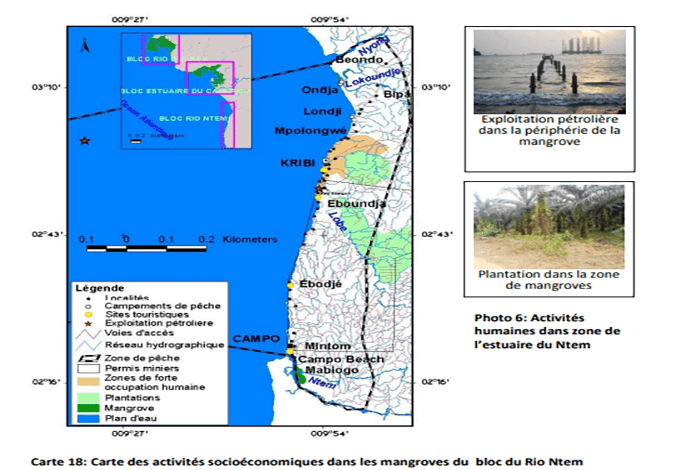Environment: The Challenging Mangrove Restoration in Lokoundje

Environment: The Challenging Mangrove Restoration in Lokoundje
The Global Environment Protectiv association introduced a mangrove regeneration project in the Ocean department, South region, to combat the degradation of this ecosystem, but it failed to achieve the hoped-for results. Among the 3,800 ha that were reforested, only about 1,300 ha of mangroves have survived. Experts point that the lack of a monitoring and evaluation system was the main reason for this failure .
A few mangrove shrubs can be found on a surface area of more than 2 ha. They are scattered among the vegetation on the banks of the Lokoundje River, in the Lohovi neighbourhood, Ocean department, South region, and range in size from one tree to the next. Roots are stuck in the puddles formed by the rising river. « Plants have been planted in all these areas. But some of them did not survive, » lamented Aeia Barth, a resident who points to the vast expanse of vegetation on the banks of the Lokoundje River.
These seedlings, which obviously show signs of poor growth, are the remnants of the propagules planted in 2019 with the aim of recreating mangroves (coastal and humid ecosystems, formed of plant species that develop in the tidal range) of this municipality. An action of the association Global Environment Protectiv (GEP) in collaboration with the Foundation for Environment and Development in Cameroon (FEDEC) within the framework of the project « Regeneration of mangroves and population engagement, especially women and indigenous communities in the conservation of these ecosystems in Lokoundje« .
According to Mbeya Boniface, the promoter of GEP, 7,000 mangroves were to be planted. 6,443 were actually planted in four villages of the Lokoundje subdivision, on the left bank of the Nyong River. These include Lohovi, the largest site covering an area of 2.5 ha, Hondja (6000m2), Bondjondji (3000m2) and Peloton (3000m2). He explained that « we observed a loss of speed in the Lokoundjé Embouchure mangrove. It was deteriorating as a result of human activity, with the cutting of mangroves to smoke fish. »
According to the Cameroon Mangrove and Wetlands Conservation Network (Rcm), this municipality in southern Cameroon is known for the density of its ecosystem and is a main mangrove concentration area in the Ntem estuary, the source of envy. In fact, in this region of the South Continental Ocean, inhabitants who earn their living mainly from fishing, use the mangrove trunks to smoke fish, with a view of long-term conservation. His Majesty Joseph Mapaka, Chief of the Lokoundje village said that, » through this project, we have realised that for ages we have been destroying nature unknowingly. To our people, it was just firewood. This, unaware of its importance for the coastal protection. We finally understood that the gradual rise of the sea and even the numerous floods in the Lokoundje River are partly due to the fact that we are destroying the mangrove. »
Although beneficial, the restoration unfortunately did not bear the expected fruit. Patriarch Joseph Mapaka regretted, » we were pleased to see the seedlings emerging from the ground a few months later. Unfortunately, two to three years after, I can conclude that the Lohovi site is a failure. » According to the GEP, a total of 3,800 ha of mangroves have been reforested, but the mangroves have only survived on an area of about 1,300 ha. Boniface Mbeya lamented, « several seedlings died or disappeared on more than 2 ha. Only three sites succeeded. Lohovi, which was our great hope because it was the largest site, has become our greatest disappointment. »
Monitoring and Evaluation
In his view, the cause is natural. He said, » one reason is the floods. When the water rises, the manatees reach the swamps and eat the seedlings. It also happens that the soil of this site is undergoing natural degradation. We suspect that there might be a deposit that prevents the plants from reproducing easily. Because everything that was planted there is dying. »
To succeed in such a plantation, Pascal Ebogo, expert in mangrove reforestation and head of the sector of the National Forestry Development Support Agency (Anafor) in the Ocean, Littoral and South-West, explained that several parameters must be integrated. He added, « the success of propagule planting depends on maintenance, the choice of species and the site. In a site, you have to take into account the tidal flooding, the height of the flooding, the speed of the ebb and flow, the salinity of the tidal waters, the supply of fresh water, the texture of the soil, the presence of sediments in the tidal waters and the temperature of the sea water. »
Albert Mbotto Ndomi, an environmental expert and member of the Rcm, pointed out another important factor that has been overlooked is the lack of meaningful maintenance and monitoring over the years. Regeneration of mangroves, he noted, requires between 75 and 90 days of intensive maintenance from the date of planting. He added that, « some seedlings die while others are damaged by crabs, eroded, or wilted. It requires good monitoring and intensive maintenance for up to 120 days in a row. The minimum is 75 days. All this should be accompanied by measures to facilitate drainage, eliminate waste and brush to prevent erosion. » According to him, projects initiators have not sufficiently matured the project or surrounded themselves with all the necessary expertise.
Despite this setback, GEP continues to work hard. During the follow-up, the project coordinators replaced the dead seedlings by planting 500 new propagules in Lohovi. He explained that, « this turn, we threw seedlings in through stilt roots because access was very difficult during the flood« . These new trees will fill the gap created by abusive exploitation of mangroves in Lokoundje.
Ntem Estuary
In fact, GEP noted that between 2015 and 2018, intact mangrove cover in the Lokoundje regressed by nearly 8% for an area of about 50 ha along the Nyong and Lokoundje rivers and along the maritime coast from Londji to the estuary. Between 2000 and 2015, this coverage was estimated at 42% for a surface area of 1,038 ha, based on the report « Atlas of mangroves in Cameroon » published in June 2017 by the Ministry of Environment, Nature Protection and Sustainable Development (Minepded)) in partnership with Rcm. According to Dr Gordon Adjonina, national coordinator of the Rcm, mangrove degradation in Lokoundje is alarming because it serves as an effective stabiliser for the Ntem estuary area.
Overall, Albert Augustin Mbotto Ndomi warns, this estuary is undergoing a serious deterioration. According to the above-mentioned report , the area’s mangrove forests have been reduced by about 15% of their original size. He explained that, » the urban development of the city of Kribi and some people seeking land are destroying mangroves to acquire them as well as some large development projects. Added to this is the abusive and illegal exploitation of mangroves use as firewood in the fishing camps of Yoyo, Mombo and Londji. »
Cecile Bibiane Ndjebet, national president of the Cameroon Ecology Association, opined that « the situation is not yet alarming in Lokoundjé as well as in the subdivision of Kribi II where mangroves in Mpalla, Ebouye and Londji villages are in an extreme state of deterioration”. However, this ecologist points out that there is an urgent need to think about their sustainable and efficient management, involving civil society, the government and local communities.
Alternative Solutions
Among the solutions to deforestation, the Ocean department has recorded, in addition to the reforestation project led by the GEP association, the reforestation programme of the Mpolongwe I mangrove over an area of one hectare and the « Coast » project which regenerated the degraded mangrove site of Londji I. These two projects benefited from the support of the Minepdep and the Ministry of Tourism and Leisure. Benjamin Haman, Minepded Ocean Divisional Delegate said, « the government through the divisional delegation of Minepdep for the Ocean accompanies all NGOs and associations that are involved in the preservation of mangroves. The permanent monitoring is also done by us on all reforested sites. »
To back up the actions of civil society, Vandelin Nkoa, Mayor of the Lokoundje municipality, said that his town planned to launch a large-awareness campaign for the population to preserve mangroves. He noted that « we will have to extend the awareness campaign to all villages along the coast in this subdivision. » If awareness-raising stops in one or two villages, others will continue to use mangroves. And we won’t achieve the hoped-for result of sustainable management. » Nevertheless, the Mayor recommends thinking about finding a stopgap measure to replace the use of mangroves as firewood.
In this regard, the Ocean divisional delegation of Minepded is planning reforestation of a fast-growing species as a solution to the use of mangrove trees as firewood by fish smokers. Furthermore, the Mayor of Lokoundje suggests that electric stoves should be made available in every hut in the village. This idea is shared by Albert Mbotto, who also suggests, « promoting the use of electric stoves to reduce the use of mangroves as firewood ». In addition to all these actions, Cécile Ndjebet insisted, « the municipalities should prohibit anarchic constructions in the mangrove areas. As well as development projects that destroy mangroves as part of their environmental and social management plan”.
Lazare Kingue












